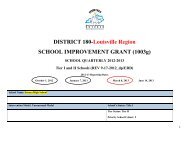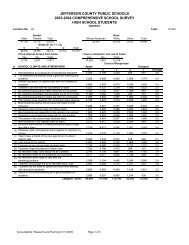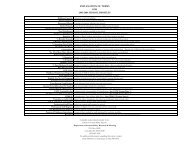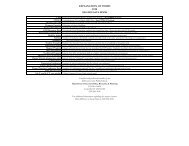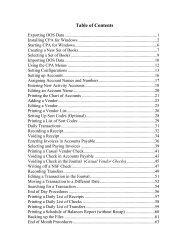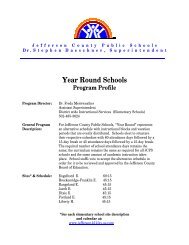HPSE Program Booklet Overview/Benefits - Jefferson County Public ...
HPSE Program Booklet Overview/Benefits - Jefferson County Public ...
HPSE Program Booklet Overview/Benefits - Jefferson County Public ...
Create successful ePaper yourself
Turn your PDF publications into a flip-book with our unique Google optimized e-Paper software.
Section I<br />
<strong>Program</strong> Summary<br />
2013-14<br />
Health<br />
Promotion<br />
Schools of<br />
Excellence<br />
Mission<br />
<strong>HPSE</strong> is a Coordinated School Health (CSH) <strong>Program</strong><br />
designed to promote and maintain healthy lifestyles and to<br />
reduce health-risk behaviors of students, staff, and parents.<br />
Goals<br />
Our goals are directly in line with our <strong>HPSE</strong> partnering<br />
agencies’ goals. We strive to improve health knowledge, attitudes,<br />
skills, and behavior related to:<br />
• Cardiovascular disease.<br />
• Cancer prevention and early detection.<br />
• Injury prevention.<br />
• Physical fitness.<br />
<strong>HPSE</strong> Specialists<br />
The <strong>HPSE</strong> <strong>Program</strong> is a branch of JCPS Health Services.<br />
<strong>HPSE</strong> <strong>Program</strong> Specialists assist their assigned schools by:<br />
• Spearheading the <strong>HPSE</strong> cross-country program for<br />
students, securing medals, ensuring that all paperwork is<br />
submitted before students participate, and making sure<br />
coaches are trained accordingly.<br />
• Meeting with assigned schools’ <strong>HPSE</strong> Committee once<br />
a month to develop plans, review data, and conduct applicable<br />
programs.<br />
• Assisting schools with fitness testing, including walk/run<br />
and measuring height and weight to calculate body mass<br />
index (BMI).<br />
• Assisting schools with data entry, reviewing data for<br />
preparation of parent reports, and delivering the reports.<br />
• Preparing and distributing health education materials,<br />
including reports, bulletins, and such visual aids as data<br />
reports, photographs, and posters to <strong>HPSE</strong> schools.<br />
• Developing and presenting health education and promotion<br />
programs, such as classroom nutrition lessons, handwashing<br />
lessons, CSH training workshops, and professional<br />
development for school staff and parents.<br />
• Assisting schools with <strong>Program</strong> Review.<br />
• Assisting school staff in implementing health programs<br />
and objectives and meeting <strong>HPSE</strong> goals and requirements.<br />
School Process and Implementation<br />
Application Process<br />
Each school must submit an application to be considered for<br />
participation in the <strong>HPSE</strong> <strong>Program</strong>. Participating schools form<br />
an <strong>HPSE</strong> Committee to serve as their school health council and<br />
actively work toward a sustainable wellness policy. <strong>HPSE</strong> schools<br />
will implement CSH policies and practices in each of the eight<br />
areas of CSH, which will help meet the demonstrator goals of the<br />
KDE <strong>Program</strong> Review for PL/CS. See the Appendix for a copy<br />
of the complete <strong>HPSE</strong> <strong>Program</strong> application.<br />
School Requirements<br />
The application includes a commitment to meeting certain<br />
requirements. The requirements include:<br />
• Retaining a school-site <strong>HPSE</strong> coordinator to spearhead<br />
the program.<br />
• Maintaining a five-person <strong>HPSE</strong> Committee to meet<br />
monthly and to help plan and implement the program.<br />
• Sending representatives of the school <strong>HPSE</strong> Committee<br />
to the Summer Health Institute.<br />
• Notifying parents concerning the school’s participation<br />
in the program, informing them of the assessments being<br />
administered, and providing exemption forms.<br />
• Administering Physical Best assessments.<br />
• Sending reports and updates home to parents.<br />
• Sharing the school’s Physical Best summary data report with<br />
the school <strong>HPSE</strong> Committee and administrators.<br />
Physical Best Testing<br />
• All kindergarten through grade-five students and all<br />
students in sixth through twelfth grades who participate<br />
in a health and/or PE class are tested.<br />
• Each <strong>HPSE</strong> school is required to administer a 1-mile walk/<br />
run four times a year (1/2-mile option for 5- to 9-year-olds<br />
only) and to measure each student’s height and weight to<br />
determine BMI twice a year. Schools may opt to administer<br />
sit-ups, pull-ups, and sit-reach testing as additional assessments.<br />
• Each student’s walk/run results are compared to standards<br />
set by the American Alliance for Health Physical Education<br />
Recreation and Dance (AAHPERD).<br />
• In the fall and spring, parents receive the Physical Best<br />
Health Report Card, which explains their child’s test<br />
results.<br />
• BMI results are plotted on a Centers for Disease Control<br />
and Prevention (CDC) growth chart to determine BMIfor-age<br />
status and percentile range.<br />
See the Appendix for more details on Physical Best testing.<br />
3




